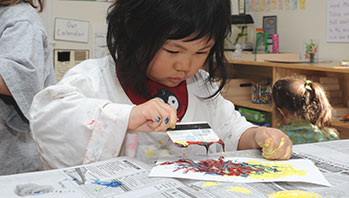- claw clips
- paint (various colors, including black and white)
- food trays (clean, plastic)
- sponges (cut into different shapes)
- color
- mix
- paint
- shade
- sponge
MA Standards:
Language/L.PK.MA.6: Use words and phrases acquired through conversations, listening to books read aloud, activities, and play.
Head Start Outcomes:
Language Development/Expressive Language: Engages in communication and conversation with others.
Approaches to Learning/Initiative and Curiosity Demonstrates flexibility, imagination, and inventiveness in approaching tasks and activities.
Approaches to Learning/Initiative and Curiosity Demonstrates eagerness to learn about and discuss a range of topics, ideas, and tasks.
PreK Learning Guidelines:
English Language Arts/Language 4: Engage in play experiences that involve naming and sorting common words into various classifications using general and specific language.
Sponge Painting

© Commonwealth of Massachusetts, Department of Early Education and Care (Jennifer Waddell photographer). All rights reserved.
Skill Focus: Color Recognition, Creative Expression, Follow Directions, Listening and Speaking, Vocabulary
Tell children they will make sponge paintings. Show children how to dip and press the sponge into the paint and then let them make their own sponge painting.
- Begin by demonstrating how to wet a sponge and squeeze out the excess water before placing it into the paint. Explain that if the sponge is too wet, the paint will be watery and drip.
- Place a small amount of different colored paint on the food trays. Guide children to carefully put the sponge into a color, and press on it gently.
- Then have them place it on a sheet of paper and press with the flat palm of their hand. Say, Carefully press the sponge in the paint. Then move the sponge onto the paper and press it gently to make the shape of the sponge on the paper. Tell children they can move and press the sponge a few times before placing it into the paint again.
Have children repeat the process with another sponge and a different color. As children work, ask questions such as, What do you think will happen when you mix colors with the sponges? Have a volunteer put one color on top of another.
Encourage children to name the different colors and describe how they are making new colors or shades of a color as they make their sponge paintings.
Adaptation: For groups with children looking for a challenge, have pairs make and copy patterns with the shapes of the sponges.
Adaptation: For children who have tactile sensitivities, you may want to clip claw clips to the sponges so children can use them as handles to press the sponges into the paint.
Adaptation: The sponge painting activity can be demanding on younger children; they may need one-on-one attention to help with fine motor skills.
